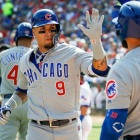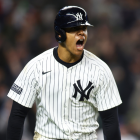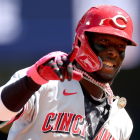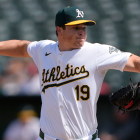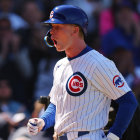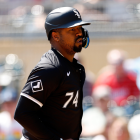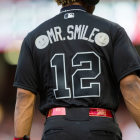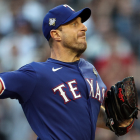Thursday occasioned the holy day of obligation known as Opening Day, and we provided you with the blow-by-blow (as we'll do for every day of the season). Since Opening Day means that every team winds up temporarily winless or undefeated (minus the occasional Japan Series participants), conditions are always ideal for snap judgments. So let us make some of those! We'll do so with a focus on four Opening Day performers in particular. Onward.
Sale's velocity not a major concern
Sale against Seattle on Thursday night endured the worst start of his Red Sox career:
Of Sale's 76 pitches, 45 went for strikes. Control wasn't necessarily the issue, but command and allowing damage on contact were. Also troubling is that Sale's fastball velocity was at 92.8 mph. Last year, Sale's four-seamer averaged 95.6 mph. Let's not overreact, as velocity tends to be down early in the season for most pitchers. Indeed, take a look at Sale last season:
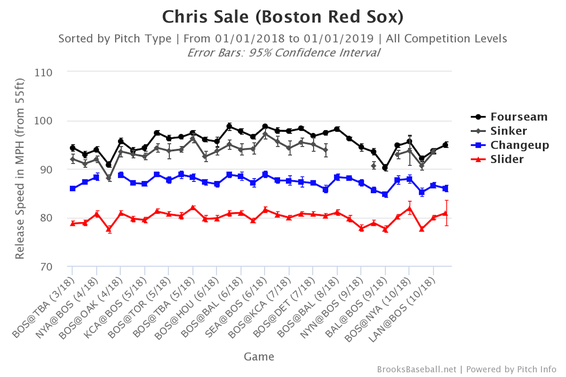
You can see above a couple of starts in which Sale's fastball velocity reached uncommon depths, and indeed his sinker dipped below 90 in his fourth appearance of 2018 (it was 91.5 on Thursday). More broadly, velocity loss is natural, and Sale has the four-pitch repertoire to cope with it.
Also, compare Sale's year-by-year average fastball velocity to his year-by-year results at the ERA+ level (the higher the ERA+, the better from the pitcher's standpoint):
| Year | Average fastball mph | ERA+ |
|---|---|---|
2012 | 93.5 | 140 |
2013 | 94.4 | 137 |
2014 | 94.9 | 173 |
2015 | 95.6 | 114 |
2016 | 93.6 | 121 |
2017 | 95.1 | 157 |
2018 | 95.6 | 207 |
It's hard to find much of a direct relationship between Sale's fastball velocity and his success at the run prevention level. No doubt, Sale would prefer to be sitting 95 or better at all times, but he's proved in the past that he can gets outs at an elite level despite inconsistent gun readings.
On another level, Sale's primary problem on Thursday was the homer, and giving up homers -- while certainly indicative of skill over the long haul -- is prone to random variation. Needless to say, this is especially the case when we're talking about a single start in late March.
There's naturally some hand-wringing because Sale is gangly, has some unconventional-looking mechanics, turns 30 this weekend, and just inked a nine-figure contract. Health and stamina are legitimate concerns (as they are for any hurler), but depressed velocity in the first start of the season isn't any reason to overreact. He's been here before.
Beckham can't keep this up, can he?
Speaking of the Red Sox-Mariners encounter, peep what Tim Beckham did for Seattle at the expense of Sale:
Yep, he went yard twice against the defending champs. Beckham also tallied five hits in seven Japan Series ABs prior to this, so he's obviously off to a magma-hot start in 2019. Specifically, Beckham is batting .583/.643/1.417 with three homers in as many games.
Let's point out the bleedin' obvious and say that Beckham obviously isn't going to maintain anything close to such a clip. Beckham does have in his favor a couple of promising early trends. First, he's yet to strike out this season (while drawing a pair of unintentional walks). Second, his average exit velocity checks in at a robust 93.9 mph, which is in the top one percent of the league thus far. Again, it's obscenely early, but avoiding strikeouts and hitting the ball hard are two indicators that become meaningful pretty early. Not this early, mind you, but it does bear monitoring.
Also, bear in mind that Beckham, now 29, was once regarded as an elite talent. The Rays made him the No. 1 overall pick back in 2008, and he was a regular on top-100 prospect lists for the early years of his career. In the bigs, he's got a career OPS+ of 102, which is a good figure for a middle infielder, and he's averaged 21 home runs per 162 games played. That's all despite erratic playing time at the highest level. This all raises the possibility that Beckham may have unlocked something. To repeat, the sample size isn't close to large enough to make any lasting estimations, but it all adds up to "keep an eye on him" status moving forward.
Peak Baez still to come?
Cubs infielder Javier Baez last season made the All-Star Game, won a Silver Slugger, and finished second in the NL MVP balloting -- all with good reason. Anecdotally, though, a number of observers seemed to think Baez would be in for regression in 2019. Maybe he will be, but Opening Day in Arlington provided no signs of it:
Our own Matt Snyder tweeted some thoughts about that first Baez dinger:
He’s collapsing his back leg, pulling off (which means barrel drops), catcher is ready to block ... and it’s a home run to left on an 0-2 curve. You can’t teach that level of talent pic.twitter.com/6r8VHCfZj3
— Matt Snyder (@MattSnyderCBS) March 29, 2019
Yes, Baez strikes out a lot and doesn't draw many walks, but his ability to do damage on contact -- thanks in large measure to his elite bat speed -- is tremendous. Look at again at that screengrab. He pulled that pitch to left center. Yes, he made statistical strides last season, but his HR/fly-ball rate and batting average on balls in play, while they spiked, aren't terrible out of step with his career norms. Baez is also still just 26. Don't be surprised if Peak Baez isn't just a 2018 phenomenon.
Harper won't always be vintage Harper
Bryce Harper of course made his much ballyhooed debut with the Phillies on Thursday, and while the Phillies won Harper didn't do much at the plate:
Harper was cheered raucously early in the game, but following his second and final strikeout of Opening Day he got Philly'd up by a handful of paying customers:
Look, there's nothing to take away from four plate appearances other than the self-evident observation that Harper went hitless in his first game with the Phillies. The lesson writ small, though, is that Harper isn't always vintage Harper. He's capable of performing at an elite level over the course of a full season, as we saw in 2017 and most especially his MVP season of 2015. However, he's also capable of being merely fine, as we've seen in two or three other seasons.
For instance, here are the WAR figures that Harper has posted in each season of his big-league career: 5.2, 3.7, 1.1, 10.0, 1.5, 4.6, 1.3. For the uninitiated, here's a table from FanGraphs that lays out the general ranges for a full-season WAR:
Scrub | 0-1 WAR |
Role Player | 1-2 WAR |
Solid Starter | 2-3 WAR |
Good Player | 3-4 WAR |
All-Star | 4-5 WAR |
Superstar | 5-6 WAR |
MVP | 6+ WAR |
So Harper at various points has ranged from role player in value to good to superstar to mega-MVP. WAR, of course, accounts for defense and base-running. Strip away those elements and focus solely on Harper's bat and you see similar trends. Here are his OPS+ figures for each full season: 118, 133, 111, 198, 114, 157, 133. Again you see wide swings, albeit not quite the depths you see from his WAR.
Harper is going to be in Philly for 13 seasons, and you're going to see many different versions of him over that decade-plus. It's reasonable to think he'll win multiple MVPs with Philly, but he'll also spend extended time in a performance trough. You pay for the peaks, abide the valleys.
He'll get cheered and booed, just as he was on Opening Day.

















